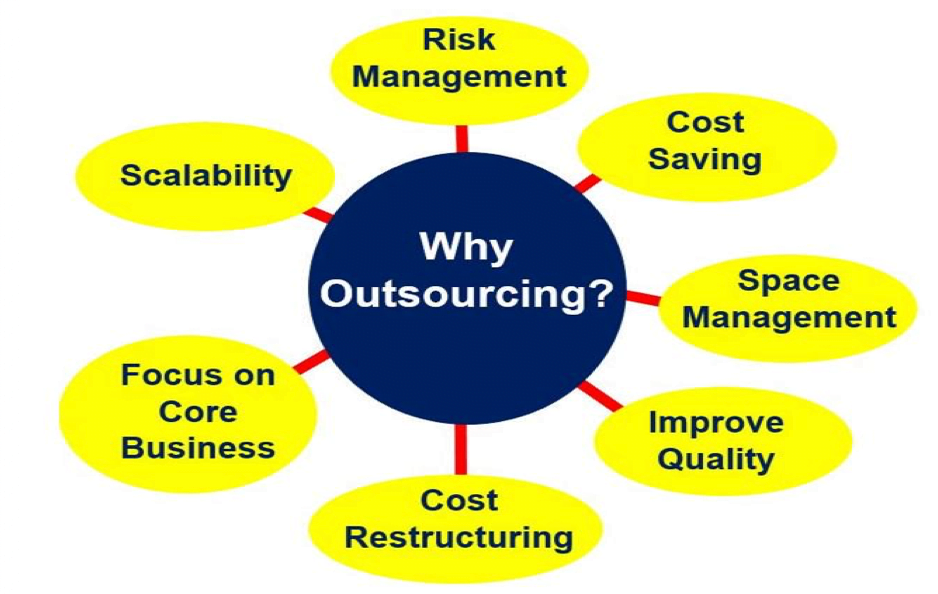Finding ways to streamline operations and optimize productivity has become critical for organizations to keep ahead in today’s increasingly competitive business market. Outsourcing is one method that has become increasingly popular. Businesses can focus on their core capabilities and achieve increased efficiency and growth by assigning specialized duties to external service providers. In this essay, we will delve into, investigating its advantages and how it may assist organizations of all sizes.
The practice of engaging an external company or individual to execute specific duties, functions, or services that were previously handled within an organization is referred to as outsourcing. Instead of depending entirely on internal resources, businesses assign specific processes or tasks to third-party entities, which are frequently located in various geographic regions.
Customer service, information technology (IT) support, manufacturing, accounting, human resources, and other parts of business operations can all be outsourced. Companies make a strategic decision to harness the specialized expertise, cost efficiencies, and flexibility provided by external service providers.
Companies outsource for a variety of reasons. One significant motive is cost savings, as outsourcing is frequently less expensive than retaining dedicated in-house teams. Organizations can focus their resources on key business activities and increase overall efficiency by outsourcing non-core functions. Outsourcing might also provide access to specialized skills and technology that may not be available in-house.
There are various types of outsourcing. Offshore outsourcing is employing service providers in overseas nations, which often have cheaper labor costs. Nearshore outsourcing, on the other hand, entails collaborating with service providers in neighboring or surrounding countries. Onshore outsourcing is the practice of hiring service providers from the same country.
While outsourcing has many advantages, it also has certain drawbacks. Communication and coordination between the Outsourcing Organisation and the external provider can be difficult at times, especially when multiple time zones and cultural differences are involved. When sharing sensitive information with third parties, data security and intellectual property protection are also crucial issues.

Recognizing Outsourcing
Contracting out specific company processes or functions to third-party providers is referred to as Outsourcing. These vendors are often experts in their domains, providing a variety of services such as customer service, IT assistance, accounting, marketing, and more. Companies can access specialized talents and resources that may not be available in-house by leveraging the expertise of these external providers.
The Benefits of Outsourcing
Cost Savings:
One of the key reasons firms opt to outsource is to save money. Outsourcing minimizes the need to hire and train new employees, provide office space, and purchase expensive equipment. Companies can instead pay for the precise services they demand, considerably cutting overhead expenditures.
Access to Expertise Outsourcing :
Through organizations can access a large pool of competent experts specializing in specific areas. Contract out allows businesses to engage with competent individuals who can offer high-quality outcomes, whether it’s graphic design, software development, or content writing.
Increased Concentration on Core Competencies:
By non-core work, businesses may concentrate their resources and energy on what they do best. This greater focus results in enhanced efficiency and productivity in essential areas, which drives total business growth.
Flexibility and scalability Outsourcing :
Outsourcing allows firms to scale their operations up or down as needed. External service providers can immediately modify their resources to match variations in demand, whether there is a sudden rise in demand or the need to temporarily downsize.
Reduced Time to Market:
By Farming out, businesses can reduce the time it takes to market new products and services. Businesses can reduce development cycles, meet project deadlines, and gain a competitive advantage in the market by leveraging the knowledge of external vendors.
Selecting the Best Partner Outsourcing
Choosing the correct sub-contract partner is critical to getting the most benefits. When making your decision, keep the following aspects in mind:
Knowledge and Track Record:
Consider the vendor’s knowledge and track record in your business. Look for testimonials and case studies that show their ability to provide high-quality work.
Communication and collaboration are essential for success. Check that the seller has open lines of communication and is attentive to your needs. Collaboration tools, as well as regular progress updates, are also required.
Security and Confidentiality :
Examine the vendor’s security processes and data protection measures. A trustworthy Call Center in the Philippines should have strong security practices in place to protect your data.
Cost and Value:
While cost savings are vital, value should take precedence over price alone. Look for a vendor who provides a good combination of price and quality, ensuring that you get the most return on your investment.
Conclusion
Outsourcing has changed the game for organizations trying to increase efficiency, save costs, and focus on their core capabilities. Companies can tap into specialized expertise, gain access to scalable resources, and drive overall growth by partnering with external service providers. However, it is critical to properly assess possible candidates.
